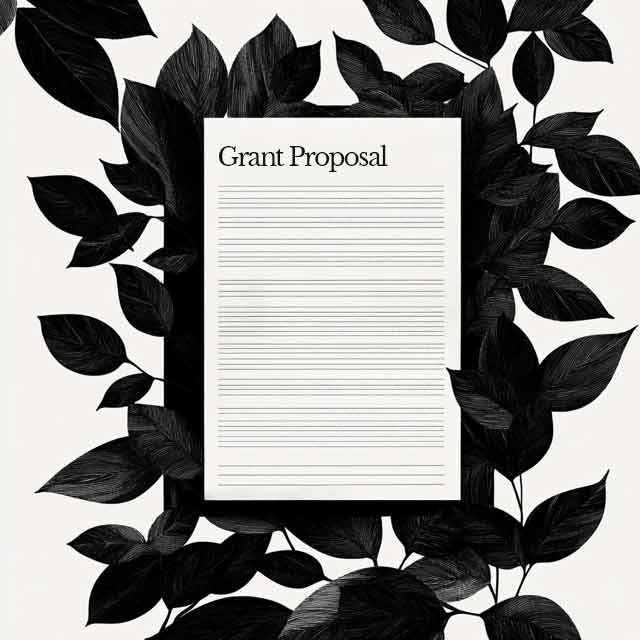Writing a grant proposal can seem like a daunting task, especially if you’re new to the process. However, understanding the basics can make it much more manageable. This guide will walk you through what a grant proposal is, why it’s important, who reviews it, and what you need to include. By the end, you’ll have a clearer idea of how to create a compelling grant proposal that stands out.

Draft a Grant Proposal with AI
Use our Grant Proposal Writer tool and save time drafting a thorough and professional grant proposal for your research or project.
What Is a Grant Proposal?
A grant proposal is a detailed request for funding, typically submitted to a government agency, foundation, or corporation. The proposal outlines a specific project or initiative, explains its purpose, and describes how the funds will be used. The goal is to convince the grantor (the organization providing the funding) that your project is worthy of their investment.
Grant proposals are often used by non-profits, educational institutions, researchers, and community organizations to secure funding for projects that might not be possible without financial support.
Why Write a Grant Proposal?
The primary reason to write a grant proposal is to obtain funding for your project. But there’s more to it than just money. Writing a grant proposal also forces you to clarify your goals, outline your plan in detail, and think critically about how you’ll measure success. This process can strengthen your project by ensuring that every aspect is carefully considered.
Moreover, a well-written grant proposal can enhance your credibility and visibility in your field. Even if your proposal isn’t funded, it can open doors to future opportunities by demonstrating your commitment and planning abilities.
Who Reviews a Grant Proposal and What Are They Looking For?
Grant proposals are usually reviewed by a panel of experts, including professionals in the field, program officers, and sometimes even past grant recipients. These reviewers are looking for proposals that are clear, well-organized, and aligned with the goals of their funding program.
Specifically, they want to know:
- Relevance: Does your project align with their funding priorities?
- Feasibility: Is your project plan realistic and well thought out?
- Impact: Will your project make a meaningful difference?
- Sustainability: Can your project continue after the grant money runs out?
- Budget: Is your budget reasonable and does it reflect the project’s needs?
Reviewers are often tasked with reading many proposals, so they appreciate concise and clear writing. The easier you make it for them to un
Understand the Purpose of the Grant
Before you start writing, it’s crucial to understand why the grant exists and what the funding organization aims to achieve. Every grant is designed with specific goals in mind, whether it’s advancing research, supporting community initiatives, or fostering innovation in a particular field. Your proposal should clearly align with these goals.
Research the Funder’s Priorities: Start by thoroughly researching the funding organization. Read through their mission statement, past grant recipients, and any guidelines they’ve provided. This will help you understand what they value and how your project can fit within their objectives.
Tailor Your Proposal: Once you know what the funder is looking for, tailor your proposal to highlight how your project aligns with their goals. Avoid using a generic proposal that you send to multiple funders. Instead, customize each proposal to demonstrate a clear understanding of the funder’s mission and how your project supports it.
Identify the Problem or Need
A successful grant proposal begins with a compelling statement of the problem or need your project addresses. Funders want to support initiatives that solve real issues, so it’s important to clearly articulate what problem you aim to solve and why it matters.
Describe the Problem: Start with a clear and concise description of the problem. Use data and evidence to support your claims, showing that the issue is significant and requires attention. For example, if you’re seeking funding for a community health project, provide statistics on the health outcomes in the area and explain why your project is needed.
Highlight the Urgency: Emphasize why the problem needs to be addressed now. Explain the potential consequences of inaction, and demonstrate that your project offers a timely and effective solution.
Propose a Solution
Once you’ve established the problem, the next step is to propose a solution. This section is the heart of your grant proposal, where you outline what you plan to do and how you’ll do it.
Define Your Objectives: Clearly state what your project aims to achieve. Objectives should be specific, measurable, achievable, relevant, and time-bound (SMART). For example, instead of saying “improve community health,” you might say “reduce the incidence of type 2 diabetes in the community by 15% over the next two years.”
Outline Your Approach: Describe the methods and strategies you’ll use to achieve your objectives. This could include activities, programs, or interventions. Be specific about the steps you’ll take and how they will lead to the desired outcomes.
Demonstrate Feasibility: Show that your proposed solution is practical and achievable. Provide details on the resources, partnerships, and expertise you’ll leverage to implement the project successfully. Funders want to be confident that their money will be well-spent, so make sure you demonstrate that your plan is realistic and well thought out.
Establish Your Credibility
Funders need to know that they can trust you to execute the project effectively. Establishing your credibility is about demonstrating that you have the skills, experience, and resources necessary to deliver on your proposal.
Highlight Your Expertise: Provide information about your organization’s background, including your mission, history, and any relevant achievements. If you’ve successfully completed similar projects in the past, highlight these as evidence of your ability to deliver results.
Showcase Your Team: Introduce the key members of your project team, including their qualifications and experience. Funders want to see that the people running the project have the expertise to manage it effectively. Include brief bios and emphasize any relevant experience that makes your team uniquely qualified to carry out the project.
Provide Evidence of Past Success: If you’ve received grants before, mention them, especially if they’re from reputable funders. Describe the outcomes of those projects and how you met or exceeded expectations. This will reassure the funder that you have a track record of success.
Detail the Project Plan
Your project plan is where you get into the specifics of how your project will unfold. This section should be clear and detailed, giving the funder a complete picture of what will happen if they choose to support your project.
Create a Timeline: Break down your project into phases or key milestones. Provide a timeline that shows when each phase will start and finish. This helps the funder understand the scope of the project and ensures they know when to expect results.
Outline the Activities: Describe the specific activities that will take place during each phase of the project. Be detailed and precise, so the funder can see exactly what their money will support. If your project involves multiple components, explain how they fit together to achieve your overall objectives.
Identify Resources and Needs: List the resources you’ll need to complete the project, including personnel, equipment, and materials. If you require specific expertise or partnerships, mention those as well. This will give the funder a sense of what it will take to bring your project to fruition.
Develop a Budget
A well-planned budget is crucial to any grant proposal. It should be realistic, detailed, and aligned with your project plan. Funders need to know exactly how their money will be spent and that you’ve carefully considered the financial aspects of your project.
Break Down Costs: Provide a detailed breakdown of all project costs, including personnel, materials, travel, and any other expenses. Each cost should be justified and linked to a specific activity in your project plan. Avoid vague or lump-sum amounts; funders want to see exactly where their money is going.
Include Justifications: For each budget item, include a brief justification explaining why it’s necessary. If you’re requesting funding for staff salaries, explain what those staff members will do and why their roles are critical to the project’s success. Justifications help funders understand the value of each expenditure.
Consider In-Kind Contributions: If your organization or partners are contributing resources to the project, include these as in-kind contributions. This could be anything from volunteer time to donated equipment. In-kind contributions demonstrate a commitment to the project and can make your proposal more attractive to funders.
Build in Contingency: It’s wise to include a small contingency fund in your budget to cover unexpected costs. However, make sure this is reasonable—typically 5-10% of the total budget—and explain what it will be used for.
Plan for Evaluation
Funders want to know how you will measure the success of your project. A strong evaluation plan shows that you’re committed to assessing the impact of your work and making improvements as needed.
Set Measurable Outcomes: Identify the key outcomes you will measure to evaluate the success of your project. These should be directly tied to your objectives. For example, if your goal is to improve literacy rates, your outcomes might include the percentage of participants who improve their reading level by a certain amount.
Describe Evaluation Methods: Outline the methods you’ll use to collect data and assess outcomes. This could include surveys, interviews, observations, or data analysis. Be specific about how you’ll gather and analyze information to determine whether your project is achieving its goals.
Explain How You’ll Use the Results: Funders want to know that their investment will lead to meaningful change. Explain how you’ll use the evaluation results to improve your project, report to stakeholders, or inform future work. This shows that you’re committed to learning from the project and making a lasting impact.
Write the Proposal
With all the groundwork laid, it’s time to write the proposal itself. This is where you bring everything together in a clear, concise, and compelling document.
Follow the Guidelines: Adhere strictly to any guidelines provided by the funder. This includes formatting, length, and the order of sections. Ignoring these guidelines can result in your proposal being disqualified, regardless of its content.
Be Clear and Concise: Write clearly and avoid jargon or technical language that may confuse the reader. Your goal is to make your proposal as easy to understand as possible. Use simple, direct language to convey your ideas, and keep sentences and paragraphs short.
Tell a Story: While your proposal should be factual, don’t be afraid to tell a story. Engage the reader by framing your project in a way that’s compelling and memorable. For example, you could start with a brief anecdote that illustrates the problem you’re addressing or the impact of your work.
Use Visuals Wisely: If appropriate, include charts, graphs, or images to illustrate key points. Visuals can help break up text and make complex information easier to digest. However, don’t overdo it—make sure any visuals you include are directly relevant to the content.
Proofread and Revise: A well-written proposal is free of errors and flows smoothly from one section to the next. Take the time to proofread your document carefully, checking for grammar, spelling, and clarity. It’s often helpful to have someone else review your proposal as well, as they may catch mistakes you’ve missed.
Submit the Proposal
Once your proposal is polished and complete, it’s time to submit it. This step may seem straightforward, but it’s important to do it carefully to ensure everything is in order.
Double-Check Requirements: Before submitting, double-check the funder’s submission requirements. Make sure you’ve included all required documents, followed formatting guidelines, and met the deadline. Missing a small detail at this stage can jeopardize your chances of getting funded.
Prepare for Submission: If the proposal must be submitted electronically, ensure that all files are in the correct format and that they upload correctly
Key Sections of the Grant Proposal
Writing a grant proposal involves creating a compelling narrative that persuades funders to invest in your project. Each section of the proposal plays a crucial role in telling that story. Below, we’ll break down the key sections of a grant proposal, explain their purpose, and provide examples to guide you in crafting each part effectively.
Executive Summary
The executive summary is the first thing reviewers see, so it’s your chance to make a strong first impression. This section should provide a brief overview of your project, summarizing its key points. Highlight the project’s importance, the goals it aims to achieve, and the funding amount requested. Think of the executive summary as your elevator pitch—it should grab attention and make the reader want to learn more.
Keep the executive summary concise and compelling. Aim for one page or less. Clearly state the project’s significance and the impact it aims to achieve. Avoid jargon and technical language; instead, use clear and persuasive language to convey the essence of your proposal.
Example
Our organization, Healthy Futures Initiative, seeks $50,000 to implement the “Youth Wellness Program” in underserved communities across the city. This program will address the rising rates of childhood obesity by providing nutrition education, physical activity opportunities, and health screenings to 500 children ages 6-12 over the next 12 months. By targeting low-income neighborhoods where access to healthy food and recreational activities is limited, our program aims to reduce obesity rates by 10% within one year. The requested funds will cover program materials, staff salaries, and partnership development with local schools and community centers.
Project Overview
The project overview section introduces your project in detail. It explains what your project entails, the problem it addresses, the target audience, and the innovative approach you’re taking. This is where you paint a clear picture of the project, helping funders understand exactly what you plan to do and why it’s necessary.
Use clear and engaging language to describe the project. Detail the scope and necessity of the project, providing evidence that supports the need for your initiative. This section should be thorough yet easy to understand, setting the stage for the rest of your proposal.
Example
The “Youth Wellness Program” is designed to combat childhood obesity in the city’s most vulnerable communities. According to recent data, 30% of children in these areas are classified as obese, a rate significantly higher than the national average. Our project will address this issue through a multi-faceted approach that includes nutrition education, physical activity, and health screenings. Over the course of 12 months, we will reach 500 children ages 6-12, working in collaboration with local schools and community centers. The program’s innovative approach combines hands-on learning with community engagement, ensuring that children not only learn about healthy habits but also have the resources and support to adopt them.
Project Goals and Objectives
In this section, you’ll outline the specific goals and objectives of your project. Goals are broad, overarching outcomes you aim to achieve, while objectives are specific, measurable steps that will help you reach those goals. This section should also explain how these goals align with the mission and vision of your organization.
Be specific and measurable when outlining your goals and objectives. Use SMART criteria (Specific, Measurable, Achievable, Relevant, Time-bound) to ensure your objectives are clear and attainable. Additionally, show how these goals align with the broader mission of your nonprofit or organization.
Example
The primary goal of the “Youth Wellness Program” is to reduce the incidence of childhood obesity in targeted communities by 10% over the next year. To achieve this, we have established the following objectives:
- Conduct 12 nutrition workshops, reaching at least 500 children, by the end of the program’s first quarter.
- Partner with 10 local schools to integrate physical activity sessions into their weekly curriculum, engaging a minimum of 400 students by month six.
- Provide free health screenings to 500 children, with follow-up consultations for those identified as at-risk for obesity-related conditions, by the program’s conclusion.
These objectives align with our organization’s mission to promote health and wellness in underserved communities, and they directly support our vision of a healthier future for all children.
Funding Needs and Budget
The funding needs and budget section presents a clear and detailed budget for the project. It breaks down the funding requirements, specifying how the funds will be allocated across different aspects of the project. Funders need to see that you’ve thought through the financial aspects of your project and that their money will be used efficiently and effectively.
Use a table or chart to present your budget clearly. Ensure transparency by providing detailed justifications for each budget item. Explain how each expense is necessary for the success of the project, and avoid vague or overly general categories. Demonstrating a well-thought-out budget can significantly increase the credibility of your proposal.
Example
| Budget Item | Cost | Justification |
|---|---|---|
| Program Materials (workshop supplies, handouts) | $10,000 | Essential for delivering nutrition workshops and activities. |
| Staff Salaries (2 full-time coordinators) | $20,000 | Coordinators will manage program logistics and community outreach. |
| Health Screenings (equipment, medical staff) | $15,000 | Necessary for conducting health screenings and follow-up consultations. |
| Partnership Development (schools, community centers) | $3,000 | Funds will be used to establish and maintain partnerships with local organizations. |
| Contingency Fund (5% of total budget) | $2,000 | To cover any unexpected costs or changes in project scope. |
| Total | $50,000 |
The requested $50,000 will cover the essential costs of implementing the “Youth Wellness Program” over the next 12 months. This budget ensures that all aspects of the program are fully funded, allowing us to reach our target audience effectively and achieve our goals.
Impact Metrics
The impact metrics section describes the metrics you will use to measure the project’s success and impact. This section is critical because funders want to know how you will assess whether the project is achieving its intended outcomes. Explain how these metrics align with the goals and objectives outlined earlier, and provide a plan for how data will be collected and analyzed.
Use quantifiable metrics to measure the impact of your project. Clearly define what success looks like and how you will measure it. Describe the methods you’ll use to collect data, and explain how you’ll analyze this data to determine the effectiveness of your project. Providing a concrete plan for evaluation shows funders that you’re serious about achieving results and willing to learn from the process.
Example
To measure the success of the “Youth Wellness Program,” we will use the following impact metrics:
- Reduction in Obesity Rates: We will track the BMI (Body Mass Index) of participating children before and after the program. Our goal is to see a 10% reduction in obesity rates within 12 months.
- Workshop Attendance and Engagement: We will monitor attendance at our nutrition workshops, aiming for at least 80% participation from the enrolled children. Additionally, we will use pre- and post-workshop surveys to assess changes in participants’ knowledge and attitudes toward healthy eating.
- Physical Activity Levels: We will measure the frequency and duration of physical activity among participants through self-reported activity logs and observations by program coordinators. Our target is to increase physical activity levels by 20% among participants by the end of the program.
Data will be collected through a combination of health screenings, surveys, and activity logs. We will analyze this data using statistical software to determine the program’s impact. The results will be shared with stakeholders, including funders, through quarterly reports and a final program evaluation at the end of the year.
Writing a grant proposal is a complex task, but by carefully crafting each section, you can create agood case for why your project deserves funding. The key sections—Executive Summary, Project Overview, Project Goals and Objectives, Funding Needs and Budget, and Impact Metrics—each serve a unique purpose in telling your project’s story. By following best practices and using the examples provided, you can write each section in a way that is clear, professional, and persuasive.
Remember, the goal is to communicate your project’s value and demonstrate that it is well-planned, achievable, and aligned with the funder’s priorities. With a well-written grant proposal, you can significantly increase your chances of securing the funding you need to make a positive impact.







